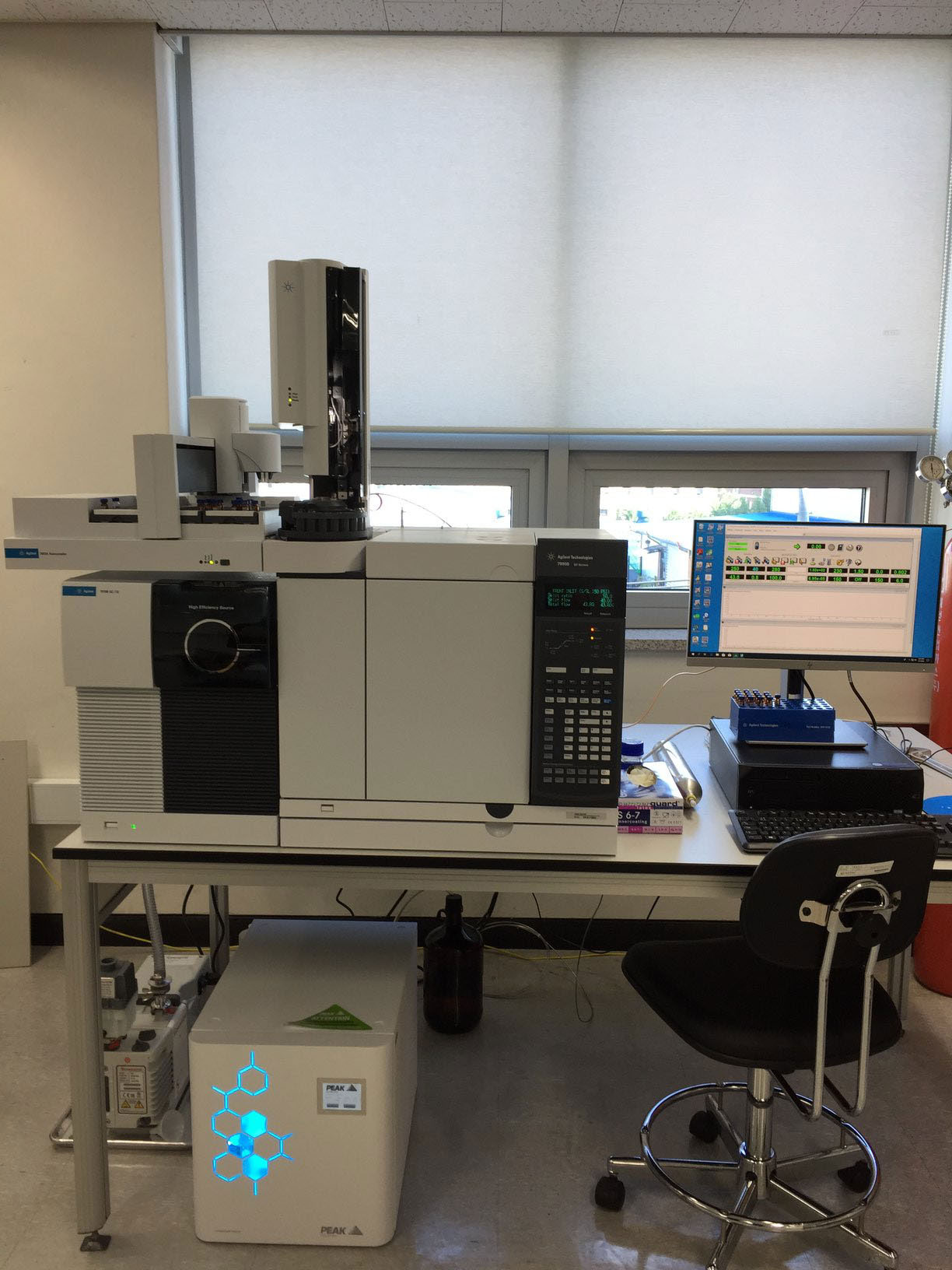From July 22nd 2019, RoHS3 (directive 2015/863) added an update to the list of Phthalate esters included in the list of regulated substances. GC-MS is now the standard method for analysis of Phthalate esters.
Abstract
As helium increases in price and availability begins to affect supply of gas to laboratories, alternative carrier gases for GC-MS analysis are increasingly being adopted. An Agilent 7010B TQ GC/MS was supplied with H2 carrier gas for the analysis of a mixture of 8 Phthalate esters including Bis(2-ethylhexyl) phthalate (DEHP), Butyl benzyl phthalate (BBP), Dibutyl phthalate (DBP) and Diisobutyl phthalate (DIBP), which are listed under RoHS3.

Agilent 7010B TQ GC/MS using Precision Hydrogen Trace for phthalate testing
Introduction
Phthalate esters are one of the most commonly detected persistent organic pollutants (POPs) and their toxicity to humans and animals has led to strict regulation regarding their use and release into the environment. Commonly used as plasticizers, large quantities of phthalates have been released into the environment, with evidence of their bioaccumulation in humans, having led to increasing regulation of their use. From July 2019, a total of 4 Phthalate esters were included on the list of restricted substances under RoHS3. DEHP, BBP, DBP and DIBP must be present below levels of 0.1% (1000ppm) in most countries, and below 0.1% (100ppm) in Japan.
Table 1. List of Phthalate restrictions in Europe, USA and Japan.
Country/Region |
Restriction/Act |
Compounds restricted |
Description of products covered |
Maximum allowable level (ppm) |
Europe |
RoHS 3, Directive (EU) 2015/863 |
DEHP, BBP, DBP |
Children’s toys |
1% / 1000ppm (sum of compounds) |
DEHP, DBP, BBP, DIBP |
Toys and childcare articles |
1% / 1000ppm (sum of compounds) |
||
USA |
US Consumer Products Safety Improvement Act (CPSIA) |
DEHP, DBP, BBP |
Children’s toys |
0.1% / 100ppm |
DEHP, DBP, BBP, DINP, DIDP, DNOP |
Any children’s toy that can be placed in a child’s mouth & childcare products |
0.1% / 100ppm |
||
OEHHA California Proposition 65 List |
DEHP, BBP, DBP, DIDP |
As above + non-toys and non-childcare products |
||
Japan |
Japan Toy Safety Standard (10th edition) & Japan Food Sanitatin Law |
DEHP, DBP, BBP |
Children’s toys |
0.1% / 100ppm |
DINP, DIDP, DNOP |
Children’s toys that can be placed in a child’s mouth |
0.1% / 100ppm |
Concerns regarding performance of GC-MS systems using H2 carrier gas are often associated with reduction of sensitivity for GC-MS analysis. For the purpose of this analysis, selected ion monitoring (SIM) detection was employed to enable reduction in interference sometimes associated with the use of hydrogen in GC-MS.
Materials and methods
Hardware |
Split/Splitless Inlet |
Agilent 7890B with 7010B GC/TQ |
Carrier gas: HydrogenInlet temperature: 250°C |
DB-5MS Column, 20m x 0.18mm x 0.18µm |
Column flow: 0.8 cc/minSplit ratio: 10:1Column temperature: 40°C for 2 min20°C / min to 300°CHold at 300°C for 2 minTransfer line temp: 280°C |
Results and discussion
The retention times and elution order of 8 Phthalate esters are shown in figure 1.

Figure 1. Chromatogram showing 8 phthalates detected in full scan mode.
Table 1. Phthalates tested, their abbreviations, CAS number and retention time
Compound |
Abbreviation |
CAS # |
Retention Time |
|
Diethyl phthalate |
DEP |
84-66-2 |
9.75 |
|
Dibutyl phthalate |
DBP |
84-74-2 |
11.61 |
|
Diethylhexyl phthalate |
DEHP |
117-81-7 |
13.26 |
|
Benzyl butyl phthalate |
BBP |
85-68-7
|
13.71 |
|
Di-iso-octyl phthalate |
DIOP |
27554-26-3 |
13.93 |
|
Di-n-octyl phthalate |
DNOP
|
117-81-7 |
14.73 |
|
Di-iso-nonyl phthalate |
DINP
|
28553-12-0 / 68515-48-0 |
14.99 |
|
Di-iso-decyl phthalate |
DIDP |
26761-40-0 / 68515-49-1 |
15.30 |
The Phthalate mixture was detected at 10ppm using full scan and all 8 phthalates were detected down to a concentration of 1ppm, using SIM detection. The results show that in full scan mode, all target compounds were detectable at 1/10 of the maximum allowable threshold for all 8 compounds and would be able to comply with testing in any region. Recovery of DINP and DIDP was not as good as the first 6 eluting phthalates. This indicates some method optimisation would be required to improve peak shape in full-scan mode.
Discussion
GC-MS analysis of persistent organic pollutants (POPs), such as Phthalates, is important in safeguarding the negative health effects of toxic chemicals present in toys and other products containing plasticizers. As an increasing number of compounds become restricted because of their toxic effect on humans, animals and the environment, it is essential that reliable analysis can be conducted to ensure that safe limits of these compounds are maintained.
In this study, hydrogen carrier gas was used with a GC-MS TQ for analysis of phthalate standards and compounds were detected down to a level of 1ppm, at least 100 times below the minimum allowed concentration. Despite concerns about loss of sensitivity when using hydrogen carrier gas for GC-MS analysis, this study clearly demonstrates that, hydrogen carrier gas can be used for analysis of phthalates.
References
ECHA Annex XVII to Reach – Conditions of restriction
U.S. Environmental Protection Agency – Phthalates action plan
Chemsafety Pro – Phthalates and REACH Annex XVII
Acknowledgements
Peak Scientific would like to thank Agilent Korea for their collaboration on this project.